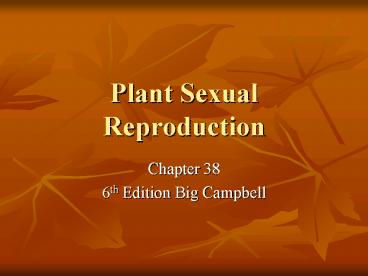Plant Sexual Reproduction - PowerPoint PPT Presentation
1 / 25
Title:
Plant Sexual Reproduction
Description:
Each pollen grain produces a pollen tube which grows in the ovary through the style ... Development of a pea pod. Seed Dormancy. An adaptation of seedling survival ... – PowerPoint PPT presentation
Number of Views:127
Avg rating:3.0/5.0
Title: Plant Sexual Reproduction
1
Plant Sexual Reproduction
- Chapter 38
- 6th Edition Big Campbell
2
Sexual Reproduction in Plants
3
Angiosperm Life Cycle
- Sporophyte
- The flower
- Dominant generation
- Diploid form
- Result of union of gametes
- Gametophyte
- Within the anthers and ovaries
- Depend of sporophyte parents
- Haploid form
- Gametes (sperm egg)
4
- During Sexual Reproduction in Plants
- Fertilization occurs in the ovary
- In the ovary is the development of the seeds
which contain sporophyte embryos - Ovary becomes the fruit
- Ovule (inside ovary) becomes the seed
5
Reproductive Organs of Plants
- Stamen male anther (pollen grains produce
sperm) - Carpal female ovary, stigma (landing platform
for pollen), style, ovule (inside the ovary
contains the embryo sac which produces the egg)
6
In order for Fertilization to Occur
- Pollen is released and lands on stigma
- Each pollen grain produces a pollen tube which
grows in the ovary through the style - Sperm released into the embryo sac (egg)
- Embryo grows
- Ovule develops into a seed
- Ovary becomes fruit
- Fruit dispersal will spread seeds
- Seedlings will grow and produce new generations
of sporophytes (flowering plants)
7
Floral Organs
- Complete Flowers
- Have all four organs sepals, petals, stamen,
carpals - A.K.A. Bisexual Flowers
- Has stamens and carpals
- Incomplete Flowers
- Lacking 1 or more organs
- A.K.A. Unisexual Flowers
- Missing either carpal or stamen
8
- Monoecious Species
- A plant that has staminate or carpellate flowers
on same plant
Dioecious Species A plant that has staminate and
carpellate flowers on separate plants
9
Gametophytes - Male
- Pollen Grain
- One microsporocyte (inside pollen sac) forms four
haploid microspores - The microspores then divide by mitosis to produce
a generative cell and a tube cell - Generative cell will form 2 sperm when lands
- Tube cell produces the pollen tube
10
Gametophytes - Female
- Embryo Sac
- In the ovary, in the ovule, in the sporangium
there is a megasporocyte that divides by meiosis
to make 4 haploid megaspores - The megaspore divides three times to form
- 3 antipodal cells (unknown function)
- 2 synergids (aid pollen tube in finding eggs)
- 1 egg
- 2 polar nuclei (not divided into individual cells
share the cytoplasm of the central cell in sac
11
(No Transcript)
12
Preventing Self Fertilization
- Dioecious plants are unisexual and therefore
cant fertilize themselves - Self-Incompatibility the plant can reject its
own pollen (Figure 38.8) - A biochemical block provents pollen from
fertilizing - Similar to animals immune system in which foreign
material is rejected, except here the self
material is rejected
13
Double Ferilization
- 1 sperm fertilizes the egg to form the zygote
- 1 sperm combines with two polar nuclei to form a
triploid nucleus - This large triploid cell gives rise to ENDOSPERM
(food storage tissue of the seed)
14
(No Transcript)
15
Embryo Development
16
Embryo DevelopmentFigure 38.10
17
Mature Seed
- Hypocotyl embryonic axis
- Radicle - embryonic root
- Epicotyl portion of the axis above the
cotyledons
18
The Ovary Becomes a Fruit
- The fruit protects the enclosed seeds and aids in
their dispersal - Fruit develops only if pollination and
fertilization are successful - The fruit ripen the same time as the seed
development is complete - Apples oranges are exaggerated versions of the
fleshy fruit variety - Wheat rice are also fruits with a pericarp that
adheres tightly to the single seed within
19
Development of a pea pod
20
Seed Dormancy
- An adaptation of seedling survival
- Condition of low metabolic rate and temporary
suspension of growth and develop - Dormancy is broken after a specific environmental
cue is given - Cues could be temperature, substantial rainfall,
intense heat by fire, extended exposure to cold,
certain hours of daylight, or chemical attack by
an animals digestive system - Cues are different for every species of plant
21
Nutrients During Germination
- The seed imbibes water (uptake of water due to
low water potential of the seed) - Embryo releases gibberellin (hormone) which
signals growth of the aleurone - The aleurone secretes enzymes to hydrolyze food
in the endosperm - The nutrients are absorbed by the scutellum and
consumed by the embryo
22
(No Transcript)
23
Emerging Seedling
- First to emerge is the radicle
- Next, shoot tip will break through soil surface
- Hypocotyl starts as a hook shape and when
stimulated by light it straightens and raises the
cotyledons - The epicotyl will emerge its first true leaves
and photosythsis begins - The cotyledons will shrivel and fall away, their
food reserve has been consumed
24
(No Transcript)
25
Your Assignment
- Take notes on the Asexual Reproduction of Plants
(pages 794 797) - Take notes on Plant Biotechnology
- (pages 797 799)
- Quiz at the beginning of the period tomorrow on
all diagrams































